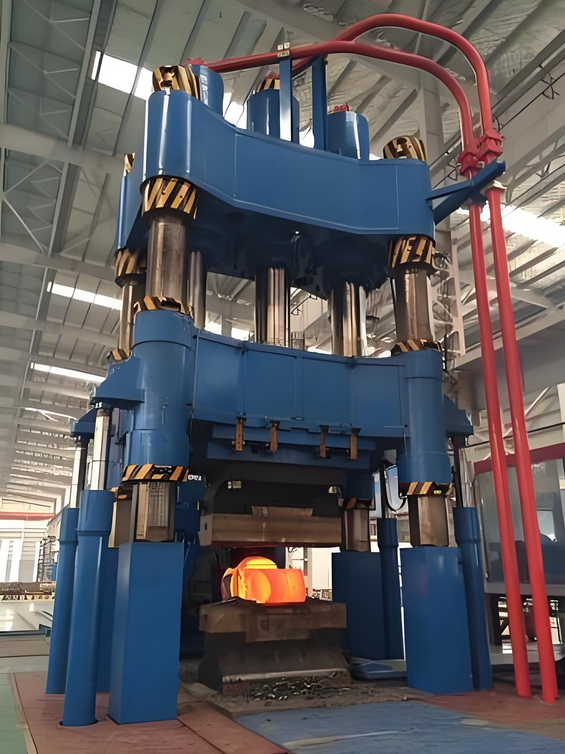
Analisis perbandingan proses penempaan dan penggulungan untuk keluli acuan
2025-07-14 15:51
Sebagai bahan utama dalam pembuatan industri, proses pengeluaran keluli acuan secara langsung mempengaruhi prestasi dan kualiti produk akhir. Penempaan dan penggulungan, sebagai dua proses pembentukan logam utama, mempunyai ciri tersendiri dalam pengeluaran keluli acuan.
Prinsip proses dan perbezaan teras
Penempaan ialah proses yang menyebabkan ubah bentuk plastik bilet logam dalam keadaan pepejal melalui tekanan atau daya hentaman, terutamanya termasuk tiga kaedah: penempaan percuma, penempaan cetakan dan penempaan cetakan tayar. Semasa proses penempaan, logam mengalami ubah bentuk plastik tiga dimensi dan penyusunan semula struktur bijian, yang boleh menghapuskan kecacatan struktur tuangan secara berkesan dan meningkatkan kekuatan dan kemuluran bahan. Sebagai bentuk penempaan lanjutan, penempaan acuan melibatkan meletakkan bilet logam yang dipanaskan ke dalam ruang cetakan penempaan berbentuk tetap dan mengubah bentuknya di bawah tekanan. Ia mempunyai kelebihan saiz yang tepat, bentuk yang kompleks, dan kecekapan pengeluaran yang tinggi, tetapi kos acuan adalah tinggi, menjadikannya sesuai untuk pengeluaran berskala besar.
Penggulungan ialah satu proses menekan dua dimensi berterusan bilet logam melalui kilang penggelek, yang dibahagikan kepada penggelek panas dan penggelek sejuk. Penggulungan panas dilakukan di atas suhu penghabluran semula, yang boleh mengurangkan penggunaan tenaga dan kos dengan ketara, meningkatkan prestasi pemprosesan logam, memecahkan butiran kasar dalam keadaan tuangan, dan mengurangkan atau menghapuskan kecacatan tuangan. Proses rolling mempunyai kecekapan yang tinggi dan sesuai untuk pengeluaran besar-besaran secara besar-besaran, tetapi mungkin terdapat masalah seperti pengedaran tisu yang tidak sekata dan saiz butiran kasar.
Struktur mikro dan sifat mekanikal
Kesan penambahbaikan proses penempaan pada struktur mikro keluli acuan adalah jauh lebih baik daripada penggelek. Semasa proses penempaan, saiz butiran bahan mentah logam ditapis dan dipesan, tanpa kecacatan tersembunyi seperti liang atau kemasukan di dalamnya, membentuk struktur penyelaras gentian yang lengkap. Data eksperimen menunjukkan bahawa penapisan bijian keluli palsu boleh mencapai 1.5 kali ganda daripada keluli bergulung, dan kadar kimpalan kecacatan dalaman lebih tinggi. Terutamanya apabila menggunakan proses penempaan tiga hala, ia boleh memecahkan struktur karbida pengasingan pusat jongkong keluli secara berkesan, kecacatan asal di dalam bahan yang dikimpal, dan dengan ketara meningkatkan rintangan haba dan rintangan keletihan bahan.
Disebabkan oleh pengehadan mod ubah bentuk, keluli bergulung mungkin mempamerkan delaminasi, mengakibatkan kemasukan bukan logam dimampatkan menjadi kepingan nipis dan menjejaskan sifat bahan. Bahagian yang ditempa mempunyai isotropi yang lebih baik, manakala bahagian yang digulung mempunyai perbezaan arah yang ketara, yang amat kritikal dalam penggunaan acuan yang menahan tegasan kompleks. Dari segi sifat mekanikal, keluli mati tempa biasanya lebih unggul daripada produk yang digulung dalam keliatan, hayat lesu, dan aspek lain, terutamanya sesuai untuk acuan pembuatan yang boleh menahan beban impak tinggi.
Kecacatan Biasa dan Kawalan Kualiti
Kecacatan biasa dalam proses penempaan termasuk saiz butiran yang besar, saiz butiran yang tidak sekata, fenomena pengerasan sejuk, retak, dll. Saiz butiran yang besar biasanya disebabkan oleh suhu penempaan awal yang tinggi dan tahap ubah bentuk yang tidak mencukupi, yang mengurangkan keplastikan dan keliatan penempaan; Saiz butiran yang tidak sekata boleh mengurangkan dengan ketara ketahanan dan prestasi keletihan penempaan; Fenomena pengerasan sejuk meningkatkan kekuatan dan kekerasan penempaan, tetapi mengurangkan keplastikan dan keliatan, dan dalam kes yang teruk boleh menyebabkan rekahan penempaan.
Masalah kualiti proses rolling terutamanya ditunjukkan sebagai taburan struktur mikro yang tidak sekata, saiz butiran kasar, komposisi bahan substandard, dan mudah berlakunya kecacatan seperti retak, lubang pasir, dan pitting. Selepas pemprosesan, ubah bentuk, keretakan, atau hayat perkhidmatan yang singkat acuan mungkin berlaku. Terutama untuk plat bergulung yang lebih tebal, adalah lebih sukar untuk memastikan kestabilan kualiti, dan kualiti tidak boleh dijamin melebihi ketebalan 200mm.
